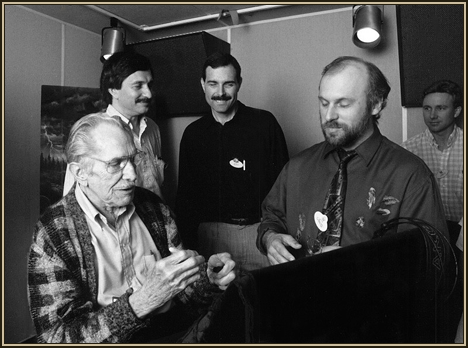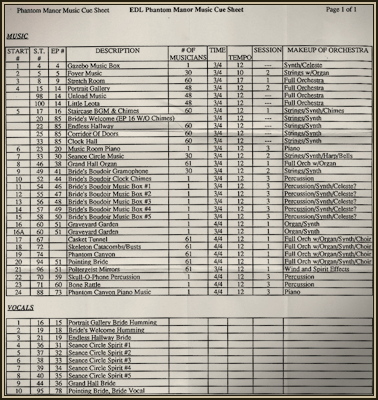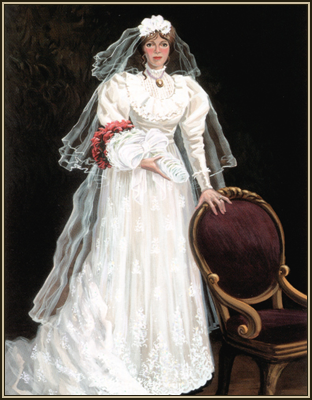
Strange & Frightening Sounds
Show writers Craig Fleming and Thierry P. Benizeau rewrote X. Atencio’s original script to reflect the new story and style of Phantom Manor, with certain parts in English and others in French. All safety announcements would be bilingual, as would be Madame Leota’s incantations and the famous “hurry back,” spoken by the character of the Bride herself in this version of the attraction. Make-up artist and actress Oona Lind was hired to record all of these haunting spiels in French and English, and her solemn, mysterious delivery ended up becoming an integral part of the ride experience.
In Spring 1990, Vincent Price was invited to the recording studios of Walt Disney Imagineering in Glendale to record the newly-written ghost host narration. Show producer Jeff Burke and Craig Fleming, who directed the actor’s performance, presented selected pieces of concept art in order to convey the mood which they wanted to achieve. Greg Meader, who recorded the session, remembers that Price “was a nice guy to work with and very much enjoyed being involved in the Phantom Manor project.”
 Left to right: Vincent Price, Ken Lisi, Jeff Burke, Craig Fleming and Greg Meader enjoying a break during the recording sessions. Left to right: Vincent Price, Ken Lisi, Jeff Burke, Craig Fleming and Greg Meader enjoying a break during the recording sessions.
The only problem, it turned out, was that the narration was planned to be in French, and the legendary actor - despite being perfect for the role - struggled with the script for a long time. Craig Fleming recalls: “We spent three-and-a-half hours working with the French script, and then at the last minute, I gave him my English version, which he did in two takes.”
Along with the eerie narration, Vincent Price recorded about a dozen different takes of his trademark evil laugh, intended to accompany the character of the Phantom throughout his appearances in the ride.
Greg Meader created a quick mix of the actor’s lines with Christian Hope’s temporary music, in order to get a first idea of how they would sound in the attraction. “At one point,” the audio producer recalls, “Jeff Burke just sat there with this look of amazement on his face as he realized that the timing of Vincent’s dialogue along with the temp music track was so exact that it was downright weird how it all fit together so well.”
When Jeff Burke was looking for the right person to adapt the music into a proper cinematic score, Fantasyland show producer Tom Morris introduced him to John Debney, who was already rewriting the music for “it’s a small world” into a big orchestral arrangement.
Debney, now a popular film composer, had done a lot of work for Disney theme parks in the 1980s and was more than happy to turn the classic “Grim Grinning Ghosts” song into a lush dramatic orchestration. As Greg Meader remembers, “John took the original Buddy Baker/X. Atencio score along with the basic mood of Christian’s piece and wrote what I think is probably the best Disney attraction score ever written.”

Detail of the music cue sheet which specifies the different cues to be recorded for the attraction. This internal document used by John Debney dates back to September 13, 1990.
Ranging from a solemn funeral waltz to eerie tinkling music box tunes or from twelve-tone disharmonics to an upbeat swing rendition, the new soundtrack was indeed turning out nothing short of amazing in the eyes of everyone involved. And although each show scene would have its own distinct music cue to underline its respective action and atmosphere, John Debney arranged it so that most of the music throughout the ride would hit the same chords at the same time, creating subtle and harmonic transitions from one cue to the next.
The final score was recorded in England, at EMI’s famous Abbey Road studios. Imagineer Don Lewis recorded the sessions as John Debney conducted a full sixty-piece orchestra. Also required were two pianos, a pipe organ, synths, chimes, various percussion and a chorus. Adding his own personal touch, Debney played several of the solo instruments himself in a separate recording session in California.
For the music box heard in the queue, the composer initially considered recreating the sound with celeste and synthesizers but soon changed his mind, as Greg Meader recounts: “John Debney wrote out the notes on paper and we had a guy who actually makes discs for music boxes create a custom disc of that piece of music. It was then played back on an actual music box owned by Media designer Glenn Barker.” He adds: “That music box and disc reside in Glenn’s home and he still plays it at parties and other special occasions.”
However, the musical star of the show, not unlike the character of Christine in Phantom of the Opera, would be the Bride herself. Much as every appearance of the evil Phantom would be accompanied by music from a pipe organ and by Vincent Price’s distinctive laugh, the Bride was to be musically represented by a haunting solo soprano, with changing moods and variations as her story would unfold over the course of the ride.

Concept art for the Bride's formal portrait by Julie Svendsen. © Disney.
Katherine Meyering-Lench, a Broadway performer who was working in the lighting department of Walt Disney Imagineering at the time, was chosen to perform the Bride vocals. She got the day off from her Imagineering duties and recorded the dramatic soprano cues under the direction of John Debney. “Jeff Burke provided me with artwork sketches to look at as I sang; it helped me get into the scenes,” the performer recalls.
It looked like some of Phantom Manor’s playful spooks already wanted their say in the matter, however... “After the entire morning of recording, they found out that there was something wrong with the recording equipment, and we had to re-record it all in the afternoon.”
The only other notable singing vocals in the attraction were not recorded specifically for Phantom Manor, but for the Haunted Mansion in the 1960s. The audio of the singing marble busts, featuring the afore-mentioned Thurl Ravenscroft as their lead singer, was transferred directly from the original master tapes, with some slight adaptions to match the newly recorded music. “It’s not quite perfect but it works well in context of the overall ride,” Greg Meader says. “There was a little moving around of the tracks involved but, overall, not bad for audio tracks recorded 25 years apart.”
Likewise, in a sort of cameo appearance, the mayor’s spiel in the ghost town finale mixes excerpts from the original Ghost Host narration recorded by Paul Frees. “Jeff Burke and myself listened to every line recorded by Paul and edited together the track that now plays back in Phantom Canyon,” Greg Meader recalls.

Jeff Burke transcribed the lines of interest on a piece of paper, which served as a kind of script in creating the final track. The imagineers ended up choosing seven isolated lines, some used in the Disneyland ride, others taken from outtakes which had never been heard before. “Technically speaking, it was a ‘new’ spiel that was, at that time, over 25 years old.”
Many of the eerie sound effects used in the attraction, however, were not recycled from the Haunted Mansion rides but re-recorded for Phantom Manor by imagineer Joe Herrington. The media designer had learned his craft from Disney legend Jim Macdonald, who had been responsible for sound effects at the Disney studio since their earliest sound cartoons and whose effects work also graced the Haunted Mansion. Greg Meader and Joe Herrington, with the aid of modern editing technology and an ever-growing sound library at their disposal, managed to create a ghostly sound environment that would be unique to Phantom Manor.
Meanwhile, the artwork and scale models were translated into full-size sets in Great Britain...

|

